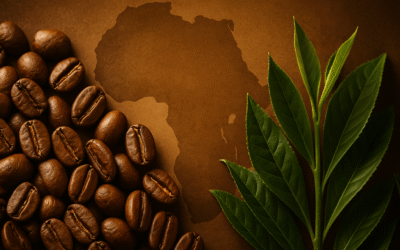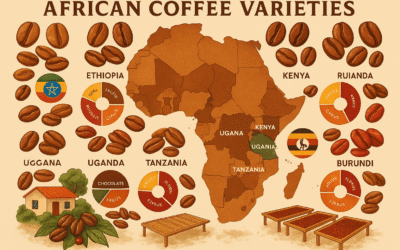African coffee farmers are pioneering innovative adaptation techniques to combat rising temperatures, erratic rainfall, and increasing pest pressures—securing not just the future of their crops but also the quality that makes African coffee distinctive on the global stage.
Introduction: Coffee’s Climate Crisis in Africa
The birthplace of coffee faces an existential threat. Across Africa’s coffee-growing regions, from Ethiopia’s ancient forests to Rwanda’s misty hills, rising temperatures and unpredictable weather patterns are transforming landscapes that have cultivated exceptional coffee for generations. With the International Coffee Organization projecting that suitable coffee-growing areas in Africa could decline by up to 65% by 2080, the continent’s iconic coffee sector stands at a crossroads.
Yet, amidst these challenges, African farmers, scientists, and industry leaders are developing some of the world’s most innovative climate adaptation strategies—approaches that may ultimately determine whether Africa’s distinctive coffees continue to thrive in a warming world.
As the Africa Coffee & Tea Expo 2025 prepares to highlight these issues this July in Kigali, we spoke with leading climate scientists and farmers pioneering sustainable solutions across the continent’s major coffee-growing regions.
The Scale of the Challenge: What Coffee Farmers Are Facing
Temperature Rises and Rainfall Disruption
“Coffee is exceptionally climate-sensitive—perhaps more than any other major crop,” explains Dr. Martin Luther Mawo, Director of Sales and Marketing at Rwanda Mountain Tea Ltd, who has studied climate impacts across East Africa. “Arabica thrives within a narrow temperature band of 18-22°C. Even small temperature increases can significantly impact yield and quality.”
Data from the Food and Agriculture Organization (FAO) indicates that many African coffee regions have already experienced temperature increases of 0.5-2°C in recent decades, with rainfall patterns becoming increasingly erratic. These shifts directly affect flowering cycles, cherry development, and ultimately cup quality.
New Pest and Disease Pressures
Climate change isn’t just altering growing conditions—it’s changing the dynamics of coffee pests and diseases. “We’re seeing coffee leaf rust at higher altitudes where it was previously unknown,” notes Dr. Mark Cyubahiro Bagabe, Rwanda’s Minister of Agriculture and Animal Resources. “Meanwhile, the coffee berry borer is expanding its range as temperatures rise.”
These combined pressures mean that business-as-usual approaches to coffee production are no longer viable across much of Africa. Adaptation isn’t optional—it’s essential for survival.
Featured Snippet: Key Climate Threats to African Coffee
- Rising temperatures: Reducing suitable growing areas and stressing coffee plants
- Rainfall variability: Disrupting flowering cycles and increasing drought frequency
- Pest expansion: Coffee leaf rust and berry borer affecting previously resistant regions
- Extreme weather events: Increasing frequency of floods, landslides, and severe droughts
- Seasonal shifts: Unpredictable seasons complicating traditional farming calendars
Farmer-Led Innovations: Adaptation From the Ground Up
Shade Management Systems
Among the most effective adaptation strategies are advanced shade management systems. “Shade isn’t just about temperature regulation—it’s a comprehensive approach to climate resilience,” explains Andrew Rugasira, founder of Good African Coffee.
In Uganda, Rugasira works with farmers implementing multi-level canopy systems that combine:
- Tall nitrogen-fixing trees for overall temperature reduction
- Mid-level fruit trees providing additional income
- Lower-level crops offering food security and soil protection
This approach can reduce temperatures around coffee plants by 2-4°C while creating more stable microclimates. “Our farmers implementing shade systems have maintained yields during extreme weather events that devastated neighboring farms,” notes Rugasira.
Water Conservation Techniques
With rainfall becoming increasingly unpredictable, water management has become critical. In Kenya, farmers working with the Coffee Research Institute have pioneered affordable water harvesting and precision irrigation systems.
“The farmers we work with have reduced water usage by up to 60% through simple innovations like shade-cloth covered water pans and gravity-fed drip irrigation,” says Caleb Karuga, Kenyan agribusiness advocate and media personality.
These water conservation approaches are particularly valuable in regions experiencing longer dry seasons and more intense rainfall events—allowing farmers to capture excess water during downpours and distribute it efficiently during dry periods.
Scientific Breakthroughs: Climate-Resilient Varieties
Drought-Resistant Coffee Development
Perhaps the most promising long-term adaptation strategy involves developing coffee varieties specifically adapted to changed conditions. At the forefront of this work is Dr. Agnes Kalibata, former Rwandan Minister of Agriculture and President of the Alliance for a Green Revolution in Africa (AGRA).
“We’re working with farmers to identify naturally resilient coffee plants that maintain quality under stress conditions,” explains Dr. Kalibata. “By combining traditional breeding with modern genetic analysis, we’ve developed varieties that can withstand 30% less rainfall while maintaining distinctive flavor profiles.”
The National Agricultural Export Development Board (NAEB) of Rwanda has established trials of these climate-resilient varieties across different altitudes, creating a valuable knowledge base for farmers throughout East Africa.
Maintaining Quality Under Climate Stress
“Climate adaptation isn’t just about survival—it’s about preserving the exceptional quality that makes African coffee world-renowned,” emphasizes Abdullah Bagersh, General Manager of SA Bagersh PLC and a respected Ethiopian coffee expert.
Bagersh notes that Ethiopian researchers have identified certain genetic traits linked to both climate resilience and flavor retention, allowing farmers to select varieties that maintain their distinctive characteristics even under stressed conditions.
“The goal isn’t just any coffee—it’s maintaining the exceptional, origin-specific profiles that command premium prices,” Bagersh adds.
Policy and Market Solutions: Beyond the Farm
Climate-Smart Certification Programs
Adaptation requires investment, and innovative financing mechanisms are emerging to support farmers. Sonia Kubwimana, Managing Director of Kinunu Wonders Ltd in Rwanda, has helped develop climate-focused certification programs that reward sustainable practices.
“Our climate-smart certification connects farmers implementing verified adaptation techniques with roasters willing to pay premiums specifically for climate resilience,” explains Kubwimana. “This creates a direct financial incentive for adaptation while giving consumers a way to support climate leadership.”
The approach is gaining traction, with companies like Trade Mark Africa helping scale these programs across multiple countries.
Regional Coordination Through ACT Expo 2025
The upcoming Africa Coffee & Tea Expo 2025 in Kigali will dedicate significant programming to climate adaptation, with a focus on practical knowledge exchange between regions.
“What works in Ethiopia may not work in Tanzania,” notes Claude Bizimana, CEO of Rwanda’s National Agricultural Export Development Board. “The Expo will facilitate region-specific adaptation guidance while creating continental coordination on research, variety development, and climate financing.”
Conclusion: From Vulnerability to Leadership
African coffee’s climate journey represents both profound challenge and remarkable opportunity. As the continent where coffee originated, Africa is now pioneering approaches that may secure the crop’s global future.
“The innovations emerging from African farms today will likely become standard practice worldwide within a decade,” predicts Dr. Juliet Kabera, Director General of Rwanda Environment Management Authority (REMA).
For coffee professionals, consumers, and sustainability advocates, supporting these adaptation efforts isn’t just about preserving African coffee—it’s about ensuring the entire industry has viable models for climate resilience.
By attending events like the Africa Coffee & Tea Expo 2025, sourcing from farmers implementing adaptation strategies, and advocating for climate financing in producing regions, stakeholders throughout the value chain can contribute to coffee’s resilient future.
After all, in a warming world, the future of coffee may well depend on the success of the adaptation strategies pioneered today in the crop’s African birthplace.
Are you involved in climate adaptation efforts in the coffee sector? Share your experiences in the comments below or contact us to contribute to our ongoing climate resilience series.





